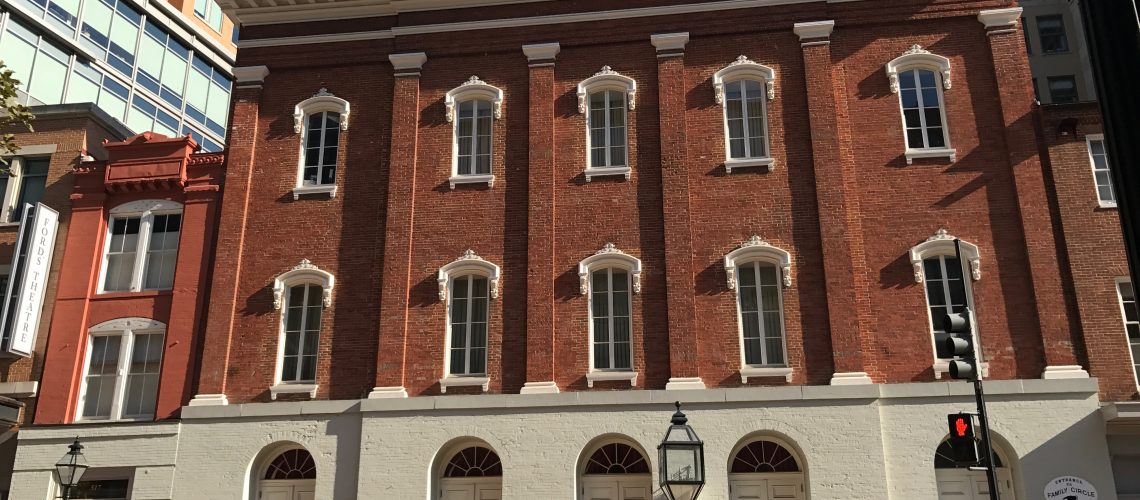Some say actors’ political opinions don’t matter. But one evening in 1865, John Wilkes Booth proved that sometimes they do.
| President | Abraham Lincoln |
| Location | Washington, DC |
| Operated By | National Parks Service, in partnership with the Ford’s Theater Society |
| When Visited | November 23, 2016 |
| Who With | Solo visit (returned that evening with my brother and a couple friends to attend a play) |
| Presidential Significance | Both the theater where Lincoln was shot and the house where he died are part of the historic site. |
| Pre-Visit Reading | Manhunt: The 12-Day Chase for Lincoln’s Killer by James L. Swanson and Assassination Vacation by Sarah Vowell. |
| Website | https://www.nps.gov/foth |
“Why you sockdologizing old mantrap!”
Hilarious, right?
John Wilkes Booth was confident that the audience would think so. He was was an actor by trade, and that was his cue. He knew that line from Our American Cousin would get a guaranteed laugh, and he used that moment to slip undetected into Abraham Lincoln’s box at Ford’s Theater and pull off one of the most significant events in presidential history.
151 years later, I had a much less eventful experience at the same theater. Well, sort of the same theater. Over time, the building was used for other purposes, fell in to disrepair, and even partially collapsed at one point before being renovated a preserved as a historic site. It’s still the same theater, however, even if the guts have been redone.

I visited the site in November 2016. My brother and I made plans to attend A Christmas Carol at the theater that night, and when I had bought the tickets for this online, I was asked if I wanted to add on a ticket for the historic site. Yes, please!
While I did in my case, you don’t have to attend a play to visit Ford’s Theater. Tickets for the historic site are available to anyone and are actually free, but there is a nominal fee (currently $3) to reserve a timed-entry ticket ahead of time. This is definitely worth it in my opinion. Not only because of all the normal reasons securing timed tickets in advance is good, but also because at Ford’s Theater, some entry times don’t include access to all parts of the historic site. When you reserve your ticket online you can see what’s available when and plan accordingly.
The Ford’s Theater National Historic Site is more than just the theater itself. The site includes the Peterson House, which is located across the street and is the building where Abraham Lincoln actually passed away. There is also a museum in the basement. The visit I write of here was actually my second visit. During my first visit, a decade earlier, I only got to see the museum (which was prior to the most recent renovation). This time I chose an entry time with all the stuff.
On the day of my visit, I arrived a few minutes early, then went to Will Call to pick up my tickets, both for the historic site and the play. There were no tickets there for me. Uh oh. Turns out I had selected the “print at home” option and had entirely failed to do so. No matter, the folks at the theater were friendly and gladly printed my tickets out for me.

After a short wait, my entry-time group was let in and promptly locked in the basement. Or, to put it another way, we were directed downstairs to the museum, and were instructed to stay there until it was our turn to visit the theater. The museum was smallish, but well done. Highlights for me were the actual gun from the assassination, and an exhibit about the group of people who conspired to kill Lincoln and several other government officials that night (Lincoln was the only successful assassination). There was also a small gift shop adjacent to the museum.
Once our museum time was up, we proceeded to the theater. To get there, we walked up a long hallway that was at an incline. On one wall there were signs noting the things that Abraham Lincoln did April 14, 1865, before his fateful visit to the theater. On the opposite wall were signs noting Booth’s activities that day. One the signs got to theater time, we entered the theater and invited to take a seat.
I made my way upstairs and found a seat in the balcony, across from the actual (recreated) box where Lincoln was shot. There it was, the spot where one of the our greatest presidents, the man who held our country together in perhaps it’s most trying hour, was eliminated by some nut-job actor from Maryland who managed to injure himself during his ridiculous escape where he dramatically jumped down to the stage and yelled some Latin at the audience (sic semper tyrannis!). It was a hallowed spot so imbued with history, it was almost as if it had religious significance. I sat in quiet reflection for a moment. Then I took selfies.

Once we were seated, a park ranger came out on stage and gave a talk, covering both the history of the theater and, of course, the events surrounding Lincoln’s assassination. As I recall, it was a really good talk. It always makes a difference when the rangers are really engaged.
Next stop was the Peterson house across the street. As I made by way there, I couldn’t help by think of the scene back in April 1865 when Lincoln was carried across this same street. It had been few years since I had read Manhunt: The 12-Day Chase for Lincoln’s Killer by James L Swanson (one of my favorite presidential history reads, but the way), but the scene depicted in the book was still very vivid.
After the initial chaos, once it became clear that Lincoln wasn’t going to pull through, those attending him decided he should not die in a theater, but also that a carriage ride back to the White House would be too much for him. Without knowing where they were going, they picked him up, and carried him out of the theater. This may have been before smartphones and social media, but news of the assassination had spread fast and the street was packed with people. They swarmed the group carrying Lincoln, reaching out to touch the dying president. An Army officer who happened to be there pulled out his sword and forced the crowd to part.
The small group proceeded to head out into the street, carrying the president’s body, surrounded by onlookers, and, again NOT KNOWING WHERE THEY WERE GOING. They had someone check the house across the street, but it was locked and no one was home. So, there they were, standing in the middle of the crowded street, holding a dying president, with no plan. With every blood clot the doctor removed to release pressure, more of Lincolns brains and other head goo oozed from his head onto the dirt and mud. And there was an Army dude brandishing a sword. Just think about that scene for a second.

Fortunately for Lincoln and for history, someone stuck their head out the door of the Peterson house, (which was next door to the first house they tried), and told them to come on in. Lincoln was already gone for all intents and purposes, but his body held on for several hours as the Peterson house became his unofficial death headquarters, where members of his family and the government met and waited.
My visit to the Peterson house was fairly brief. It is basically a walk through, where you follow the path through a few rooms. Everything was set to look like it would have that fateful night, and there were some information signs. After I had seen what there was to see there, I exited into the Center for Education and Leadership. The Center had a few floors of exhibits pertaining to Lincoln, but I did not have a ton of time so skipped these. One thing I did not miss, and could not miss, was the giant tower in the lobby made entirely out of books about Abraham Lincoln. It was pretty awesome.

Later that evening, I returned to Ford’s Theater with my brother and a couple friends to see A Christmas Carol. It was interesting to see what functioned as a historic site a few hours earlier now be just a normal theater, albeit one with flag-draped memorial box seats and a whole bunch of Lincoln merch in the gift shop.
One thing that I thought was cool is that they had the door to the museum open, so people who came for the play could go downstairs and look around without having to come back during “historic site” hours. When it was time for intermission, I made a beeline for the museum, but not to look at any exhibits. No, once I saw the throngs of other women heading towards the ladies’ room, I wisely recalled the restrooms I had seem downstairs in the museum and made my move.
There was just one other woman down there; she had also visited the museum that day and had the same thought. We shared a moment of smug superiority before we each took our pick from the row of empty stalls. Meanwhile, just one floor above, our less clever peers were standing in a line that stretched out the door. They say you should learn about history so you don’t repeat it, but sometimes in the process you learn things that provide other benefits as well.

